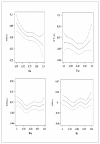Bayesian modelling of the effect of climate on malaria in Burundi
- PMID: 20429877
- PMCID: PMC2885398
- DOI: 10.1186/1475-2875-9-114
Bayesian modelling of the effect of climate on malaria in Burundi
Abstract
Background: In Burundi, malaria is a major public health issue in terms of both morbidity and mortality with around 2.5 million clinical cases and more than 15,000 deaths each year. It is the single main cause of mortality in pregnant women and children below five years of age. Due to the severe health and economic cost of malaria, there is still a growing need for methods that will help to understand the influencing factors. Several studies have been done on the subject yielding different results as which factors are most responsible for the increase in malaria. The purpose of this study has been to undertake a spatial/longitudinal statistical analysis to identify important climatic variables that influence malaria incidences in Burundi.
Methods: This paper investigates the effects of climate on malaria in Burundi. For the period 1996-2007, real monthly data on both malaria epidemiology and climate in the area of Burundi are described and analysed. From this analysis, a mathematical model is derived and proposed to assess which variables significantly influence malaria incidences in Burundi. The proposed modelling is based on both generalized linear models (GLM) and generalized additive mixed models (GAMM). The modelling is fully Bayesian and inference is carried out by Markov Chain Monte Carlo (MCMC) techniques.
Results: The results obtained from the proposed models are discussed and it is found that malaria incidence in a given month in Burundi is strongly positively associated with the minimum temperature of the previous month. In contrast, it is found that rainfall and maximum temperature in a given month have a possible negative effect on malaria incidence of the same month.
Conclusions: This study has exploited available real monthly data on malaria and climate over 12 years in Burundi to derive and propose a regression modelling to assess climatic factors that are associated with monthly malaria incidence. The results obtained from the proposed models suggest a strong positive association between malaria incidence in a given month and the minimum temperature (night temperature) of the previous month. An open question is, therefore, how to cope with high temperatures at night.
Figures
Similar articles
-
Geo-additive modelling of malaria in Burundi.Malar J. 2011 Aug 11;10:234. doi: 10.1186/1475-2875-10-234. Malar J. 2011. PMID: 21835010 Free PMC article.
-
Forecasting malaria incidence based on monthly case reports and environmental factors in Karuzi, Burundi, 1997-2003.Malar J. 2007 Sep 24;6:129. doi: 10.1186/1475-2875-6-129. Malar J. 2007. PMID: 17892540 Free PMC article.
-
Model variations in predicting incidence of Plasmodium falciparum malaria using 1998-2007 morbidity and meteorological data from south Ethiopia.Malar J. 2010 Jun 16;9:166. doi: 10.1186/1475-2875-9-166. Malar J. 2010. PMID: 20553590 Free PMC article.
-
Bayesian spatio-temporal modelling of environmental, climatic, and socio-economic influences on malaria in Central Vietnam.Malar J. 2024 Aug 24;23(1):258. doi: 10.1186/s12936-024-05074-y. Malar J. 2024. PMID: 39182127 Free PMC article.
-
Modelling climate change and malaria transmission.Adv Exp Med Biol. 2010;673:184-99. doi: 10.1007/978-1-4419-6064-1_13. Adv Exp Med Biol. 2010. PMID: 20632538 Review.
Cited by
-
Bayesian spatio-temporal analysis of malaria prevalence in children between 2 and 10 years of age in Gabon.Malar J. 2024 Feb 23;23(1):57. doi: 10.1186/s12936-024-04880-8. Malar J. 2024. PMID: 38395876 Free PMC article.
-
The role of climate variability in the spread of malaria in Bangladeshi highlands.PLoS One. 2010 Dec 16;5(12):e14341. doi: 10.1371/journal.pone.0014341. PLoS One. 2010. PMID: 21179555 Free PMC article.
-
Modeling zoonotic cutaneous leishmaniasis incidence in central Tunisia from 2009-2015: Forecasting models using climate variables as predictors.PLoS Negl Trop Dis. 2017 Aug 25;11(8):e0005844. doi: 10.1371/journal.pntd.0005844. eCollection 2017 Aug. PLoS Negl Trop Dis. 2017. PMID: 28841642 Free PMC article.
-
Structured additive regression models with spatial correlation to estimate under-five mortality risk factors in Ethiopia.BMC Public Health. 2015 Mar 19;15:268. doi: 10.1186/s12889-015-1602-z. BMC Public Health. 2015. PMID: 25884813 Free PMC article.
-
Modeling an association between malaria cases and climate variables for Keonjhar district of Odisha, India: a Bayesian approach.J Parasit Dis. 2020 Jun;44(2):319-331. doi: 10.1007/s12639-020-01210-y. Epub 2020 Mar 19. J Parasit Dis. 2020. PMID: 32508406 Free PMC article.
References
-
- Ndayiragije A, Niyungeko D, Karenzo J, Niyungeko E, Barutwanayo M, Ciza A, Bosman A, Moyou-Somo R, Nahimana A, Nyarushatsi JP, Barihuta B, Mizero L, Ndaruhutse J, Delacollette C, Ringwald P, Kamana J. Efficacité de combinaisons thérapeutiques avec des dérivés de l'artémisinine dans le traitement de l'accès palustre non-compliqué au Burundi. Trop Med Int Health. 2004;9:673–679. doi: 10.1111/j.1365-3156.2004.01255.x. - DOI - PubMed
-
- WHO. Stratégie de coopération de l'OMS avec les pays. République du Burundi. 2005.
-
- UNDP. Rapport national sur le Développement humain au Burundi. 2003.
Publication types
MeSH terms
LinkOut - more resources
Full Text Sources



